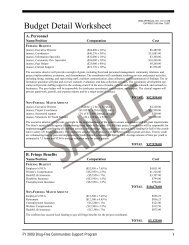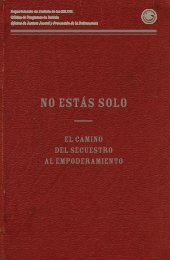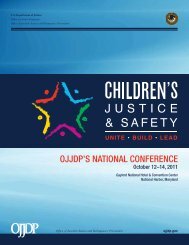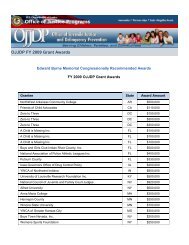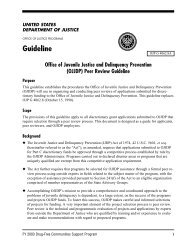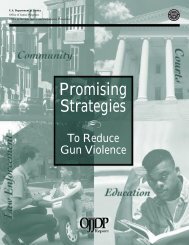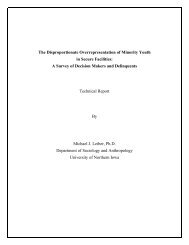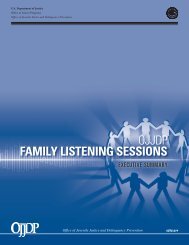Juvenile Court Statistics 2005. - Office of Juvenile Justice and ...
Juvenile Court Statistics 2005. - Office of Juvenile Justice and ...
Juvenile Court Statistics 2005. - Office of Juvenile Justice and ...
- No tags were found...
Create successful ePaper yourself
Turn your PDF publications into a flip-book with our unique Google optimized e-Paper software.
Appendix A: Methodspotential donor records defined bystrata, year <strong>of</strong> disposition, <strong>and</strong> intakedecision.Weighting to produce national estimates.The Archive employs an elaboratemultivariate procedure thatassigns a weight to each record inthe national case-level database that,when used in analysis, yields nationalestimates <strong>of</strong> juvenile court activity.The weights incorporate a number <strong>of</strong>factors related to the size <strong>and</strong> characteristics<strong>of</strong> juvenile court caseloads:the size <strong>of</strong> a community; theage <strong>and</strong> race composition <strong>of</strong> its juvenilepopulation; the age <strong>and</strong> racepr<strong>of</strong>ile <strong>of</strong> the youth involved in juvenilecourt cases; the courts’ responsesto the cases (intake decision,detention, adjudication, <strong>and</strong> disposition);<strong>and</strong> the nature <strong>of</strong> each court’sjurisdictional responsibilities (i.e.,upper age <strong>of</strong> original jurisdiction).The basic assumption underlying theweighting procedure is that similarlegal <strong>and</strong> demographic factors shapethe volume <strong>and</strong> characteristics <strong>of</strong>cases in reporting <strong>and</strong> nonreportingcounties <strong>of</strong> comparable size <strong>and</strong> features.The weighting proceduredevelops independent estimates forthe number <strong>of</strong> petitioned delinquencycases, nonpetitioned delinquencycases, <strong>and</strong> petitioned status <strong>of</strong>fensecases h<strong>and</strong>led by juvenile courtsnationwide. Identical statistical proceduresare used to develop all caseestimates.As noted earlier, all U.S. counties areplaced into one <strong>of</strong> four strata basedon the size <strong>of</strong> their youth populationages 10 through 17. In the first stepto develop the weights, the Archivedivides the youth 10-17 populationfor each stratum into three agegroups: 10- through 15-year-olds,16-year-olds, <strong>and</strong> 17-year-olds. Thethree age groups are further subdividedinto four racial groups: white,black, American Indian (includingAlaskan Native), <strong>and</strong> Asian (includingNative Hawaiian <strong>and</strong> Other PacificIsl<strong>and</strong>er). Thus, juvenile residentpopulation estimates are developedfor 12 age/race categories in eachstratum <strong>of</strong> counties.The next step is to identify withineach stratum the jurisdictions thatcontributed to the Archive case-leveldata consistent with JCS reportingrequirements. The populations <strong>of</strong>these case-level reporting jurisdictionswithin each stratum are thendeveloped for each <strong>of</strong> the 12age/race categories. The nationalcase-level database is summarized todetermine within each stratum thenumber <strong>of</strong> court cases that involvedyouth in each <strong>of</strong> the 12 age/race populationgroups. Case rates (number<strong>of</strong> cases per 1,000 juveniles in thepopulation) are then developed forthe 12 age/race groups within each<strong>of</strong> the four strata.For example, assume that a total <strong>of</strong>3,507,000 white youth ages 10–15resided in those stratum 2 countiesthat reported JCS-compatible caseleveldata to the Archive. If theArchive’s case-level database showsthat the juvenile courts in thesecounties h<strong>and</strong>led 56,039 petitioneddelinquency cases involving whiteyouth ages 10 through 15, the number<strong>of</strong> cases per 1,000 white youthages 10–15 for stratum 2 would be16.0, or:(56,039 / 3,507,000) x 1,000 = 16.0Comparable analyses are then usedto establish the stratum 2 case ratesfor black youth, American Indianyouth, <strong>and</strong> Asian youth in thesame age group (56.4, 25.5, <strong>and</strong> 9.4,respectively).Next, information contained in thenational court-level database is introduced,<strong>and</strong> stratum-level case ratesare adjusted accordingly. First, eachcourt-level statistic is disaggregatedinto the 12 age/race groups. Thisseparation is accomplished byassuming that, for each jurisdiction,the relationships among thestratum’s 12 age/race case rates(developed from the case-level data)are paralleled in the court-level data.For example, assume that a jurisdictionin stratum 2 with an upper age<strong>of</strong> original juvenile court jurisdiction<strong>of</strong> 15 reported it processed 600 casesduring the year. Also assume thatthis jurisdiction had a juvenile population<strong>of</strong> 12,000 white youth, 5,000black youth, 500 American Indianyouth, <strong>and</strong> 1,500 Asian youth. Thestratum 2 case rates for each racialgroup in the 10–15 age group wouldbe multiplied by the correspondingpopulation to develop estimates <strong>of</strong>the proportion <strong>of</strong> the court’s caseloadthat came from each age/racegroup, as follows:White:(16.0 x 12,000) / [(16.0 x 12,000) +(56.4 x 5,000) + (25.5 x 500) +(9.4 x 1,500)] = 38.3%Black:(56.4 x 5,000) / [(16.0 x 12,000) +(56.4 x 5,000) + (25.5 x 500) +(9.4 x 1,500)] = 56.3%American Indian:(25.5 x 500) / [(16.0 x 12,000) +(56.4 x 5,000) + (25.5 x 500) +(9.4 x 1,500)] = 2.6%Asian:(9.4 x 1,500) / [(16.0 x 12,000) +(56.4 x 5,000) + (25.5 x 500) +(9.4 x 1,500)] = 2.8%The jurisdiction’s total caseload <strong>of</strong>600 would then be allocated basedon these proportions. In this example,it would be estimated that 38.3%<strong>of</strong> all cases reported in the jurisdiction’saggregate statistics involvedwhite youth, 56.3% involved blackyouth, 2.6% involved AmericanIndian youth, <strong>and</strong> the remaining 2.8%involved Asian youth. When theseproportions are applied to a reportedcourt-level caseload statistic <strong>of</strong>600 cases, this jurisdiction is estimatedto have h<strong>and</strong>led 230 cases involvingwhite youth, 338 cases involvingblack youth, 15 cases involving98<strong>Juvenile</strong> <strong>Court</strong> <strong>Statistics</strong> 2005



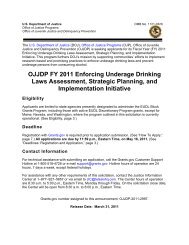
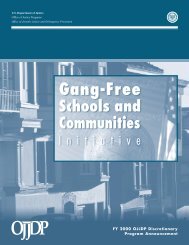
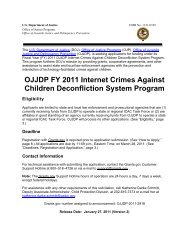
![Chapter 5 [PDF] - Office of Juvenile Justice and Delinquency ...](https://img.yumpu.com/46584340/1/190x245/chapter-5-pdf-office-of-juvenile-justice-and-delinquency-.jpg?quality=85)
